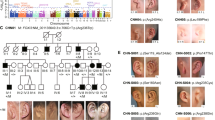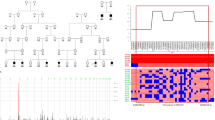Abstract
Waardenburg syndrome (WS), an autosomal dominant syndrome of hearing loss and pigmentary disturbances, comprises at least two separate conditions. WS type 1 is normally caused by mutations in PAX3 located at chromosome 2q35 and is distinguished clinically by minor facial malformations. We have now located a gene for WS type 2. Two families show linkage to a group of microsatellite markers located on chromosome 3p12–p14.1. D3S1261 gave a maximum lod score of 6.5 at zero recombination in one large Type 2 family. In a second, smaller family the adjacent marker D3S1210 gave a lod of 2.05 at zero recombination. Interestingly, the human homologue (MITF) of the mouse microphthalmia gene, a good candidate at the phenotypic level, has recently been mapped to 3p12.3–p14.4.
This is a preview of subscription content, access via your institution
Access options
Subscribe to this journal
Receive 12 print issues and online access
$209.00 per year
only $17.42 per issue
Buy this article
- Purchase on Springer Link
- Instant access to full article PDF
Prices may be subject to local taxes which are calculated during checkout
Similar content being viewed by others
References
Steel, K.P. & Bock, G.R. Hereditary inner-ear abnormalities in animals. Arch. Otolaryngol. 109, 22–29 (1983).
Spritz, R.A. Molecular genetics of oculocutaneous albinism. Semin. Dermatol. 12, 167–172 (1993).
Steel, K.P. & Barkway, C. Another role for melanocytes: their importance for normal stria vascularis development in the mammalian inner ear. Development 107, 453–463 (1989).
Waardenburg, P.J. A new syndrome combining developmental anomalies of the eyelids, eyebrows and nose root with pigmentary defects of the Iris and head hair and with congenital deafness. Am. J. hum. Genet. 3, 195–253 (1951).
da-Silva, E.O. Waardenburg I syndrome: a clinical and genetic study of two large Brazilian kindreds and literature review. Am. J. med. Genet. 40, 65–74 (1991).
Arias, S. Genetic heterogeneity in the Waardenburg syndrome. Birth Defects 7, 87–101 (1971).
Farrer, L.A. et al. Locus heterogeneity for Waardenburg syndrome is predictive of clinical subtypes. Am. J. hum. Genet. (in the press).
Tassabehji, M. et al. Mutations in the PAX3 gene causing Waardenburg syndrome type 1 and type 2. Nature Genet. 3, 26–30 (1993).
Asher, J.H. & Friedman, T.B. Mouse and hamster mutants as models for Waardenburg syndrome in humans. J. med. Genet. 27, 618–626 (1990).
Wilcox, E.R., Rivolta, M.N., Ploplis, B., Potterf, S.B. & Fex, J. The HuP2 gene is mapped to chromosome 2, together with a highly informative CA dinucleotide repeat. Hum. molec. Genet. 1, 215 (1992).
Ott, J. Analysis of Human Genetic Linkage 2nd edn (Johns Hopkins University press, Baltimore, 1991).
Naylor, S.L., Buys, C.H.C.M. & Carritt, B. Report on the Fourth International Chromosome 3 Workshop. Cytogenet. Cell Genet. 65, 1–50 (1993).
Hodgkinson, C.A. et al. Mutations at the mouse microphthalmia locus are associated with defects in a gene encoding a novel basic helix-loop-helix zipper protein. Cell 74, 395–404 (1993).
Tachibana, M. et al. Cloning of MITF, the human homolog of the mouse microphthalmia gene and assignment to chromosome 3p14.1–p12.3. Hum. molec. Genet. 3, 553–557 (1994).
Arias, S. & Mota, M. Apparent non-penetrance for dystopia in Waardenburg syndrome Type 1 with some hints on the diagnosis of dystopia canthorum. Journal de Génétique Humaine 26, 101–131 (1978).
Lathrop, G.M. & Lalouel, J.M. Easy calculation of lod scores and genetic risks on small computers. Am. J. hum. Genet. 36, 460–465 (1984).
Foy, C., Newton, V.E., Wellesley, D., Harris, R. & Read, A.P. Assignment of WS1 locus to human 2q37 and possible homology between Waardenburg syndrome and the Splotch mouse. Am. J. hum. Genet. 46, 1017–1023 (1990).
Tassabehji, M. et al. Waardenburg syndrome patients have mutations in the human homologue of the Pax-3 paired box gene. Nature 355, 635–636 (1992).
Baldwin, C.T., Hoth, C.F., Amos, J.A., da-Silva, E. O. & Milunsky, A. An exonic mutation in the HuP2 paired domain gene causes Waardenburg's syndrome. Nature 355, 637–638 (1992).
Hoth, C.F. et al. Mutations in the paired domain of the human PAX3 gene cause Klein-Waardenburg syndrome (WS-III) as well as Waardenburg syndrome Type 1 (WS-1). Am. J. hum. Genet. 52, 455–462 (1993).
Morell, R. et al. A frameshift mutation in the HuP2 paired domain of the probable human homolog of murine Pax-3 is responsible for Waardenburg syndrome type 1 in an Indonesian family. Hum. molec. Genet. 1, 243–247 (1992).
Tassabehji, M. et al. PAX3 gene structure and mutations: close analogies between Waardenburg syndrome Type 1 and the Splotch mouse. Hum. molec. Genet. (in the press).
Author information
Authors and Affiliations
Rights and permissions
About this article
Cite this article
Hughes, A., Newton, V., Liu, X. et al. A gene for Waardenburg Syndrome type 2 maps close to the human homologue of the microphthalmia gene at chromosome 3p12–p14.1. Nat Genet 7, 509–512 (1994). https://doi.org/10.1038/ng0894-509
Received:
Accepted:
Issue Date:
DOI: https://doi.org/10.1038/ng0894-509
This article is cited by
-
PAK4 signaling in health and disease: defining the PAK4–CREB axis
Experimental & Molecular Medicine (2019)
-
Association of MITF loci with coat color spotting patterns in Ethiopian cattle
Genes & Genomics (2017)
-
Creation of miniature pig model of human Waardenburg syndrome type 2A by ENU mutagenesis
Human Genetics (2017)
-
Application of Mouse Models to Research in Hearing and Balance
Journal of the Association for Research in Otolaryngology (2016)
-
Molecular genetics and cellular features of TFE3 and TFEB fusion kidney cancers
Nature Reviews Urology (2014)



